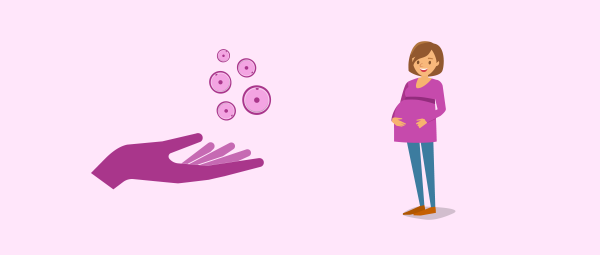As fertility technologies advance, using fresh or frozen donor eggs in conjunction with IVF treatment is an attractive, more accessible option for women struggling to conceive naturally. Egg donation at Donor Egg Bank USA helps facilitate donor egg IVF treatments while providing future parents with the support they need on this difficult path to parenthood.
Donor egg IVF has increased in popularity over the past years. For women barraged with a constant stream of negative pregnancy tests, the eagerness to become pregnant can develop into feelings of sadness, guilt, and disbelief.
Donor egg IVF aids in creating the miracle of life for you and your family. As you weigh your fertility options, it’s imperative to consider how this process can successfully build your dream family.
1. Extensive Donor Pool and Rigorous Screening
Receiving frozen eggs from a national egg bank offers future parents a larger pool of possible donors, meaning you are more likely the find the genetic match you seek. Rigorous screening processes are used to ensure egg donors meet clinical and FDA donor requirements. You are given detailed background information on the selected donors – from medical conditions to employment status or education – to help choose your perfect donor. Being given in-depth knowledge of your donor should help increase your confidence in the decision to use donor eggs and the donor selection process.
2. Affordability
IVF procedures often require a high degree of economic stability. In comparison to fresh donor egg IVF, the cost of frozen donor egg IVF is considerably less – about half the price offresh donor egg IVF. Moreover, further reduced pricing is possible when selecting a bundled treatment payment plan through certain donor egg networks. Not only will you be aware of total treatment costs, but you will have a degree of freedom in paying, as well.
3. Avoid Cancellation
Frozen egg IVF cycles are almost never cancelled, as opposed to other fertility treatments. Since the eggs are already frozen, you don’t have to rely on others throughout the process and have much more control over the timing of your frozen donor egg IVF cycle.
4. Increase Your Chances
The science behind fertility treatments is continually evolving. Currently, the success rates of frozen eggs rivals – and even surpasses -some fresh donor programs throughout the United States.
Choosing a national egg bank not only ensures the eggs are superior quality, but that the insemination process is quick and efficient in creating an embryo.
In the unlikely event that a suitable embryo is not available, there are treatment plans offered which may provide you with a replacement set of eggs. Alternatively, other plans can secure a 100% refund for couples unable to conceive a healthy baby within six full IVF cycles. While the ultimate goal is creating a new family member, these insurance policies offer peace of mind that you will receive the best possible chance for a successful pregnancy.
5. Convenience
Because frozen eggs are readily available in the donor bank, you can get started when the time is right for you. This also means you will need fewer medical appointments, require less medication, and can avoid the anxiety related to synchronizing your schedule with the donor.
The Frozen Donor Egg IVF Process
Enrollment
The very first step is enrolling with a donor egg bank. While going through this initial stage, be sure to ask questions and explore the possibility of financial plans available. Your financial commitment can play a significant role in the process – make sure you understand all that’s entailed.
Egg Donor Selection
After thoroughly reviewing the bank’s database of donors, you find your ideal match. The detailed profile you are provided with includes comprehensive medical histories, possible genetic disorders, previous pregnancies, education, employment history, and the reason for donation. You may even access a photo album of the donor, should you wish to evaluate physical attributes.
Receive the Eggs
Once you have selected your perfect donor, the bank will send her frozen eggs to the clinic of your choosing. This process is done via overnight shipping, and the fertility practice will receive between 5 and 9 mature eggs – this is the ideal number needed to produce one or more embryos for IVF transfer.
Prepare for IVF Transfer
Fertility medication is required for your body to accept the embryo and prepare the endometrial lining. Unlike the donor’s regimen, the process for recipients is easy and less invasive.
Fertilization of the Eggs
The frozen eggs are removed from cryopreservation, thawed, and combined with the partner’s sperm and incubated overnight. The process involves using a technique called intracytoplasmic sperm injection (ICSI). This scientific term means a single sperm is injected into a mature egg with a needle, rather than using a Petri dish to allow the sperm to penetrate the egg on its own.
IVF Transfer
Once fertilization has taken place, the embryos slowly start to develop. When sufficiently developed, the embryologist introduces 1-2 embryos into the uterus. A discussion between yourself and the doctor will take place beforehand to ensure you agree to the number of embryos transferred.
After the number of embryos is decided, a thin catheter is introduced into the cervix to insert the embryos. You may be asked by your doctor to rest for a couple of days following the procedure, but you may do so in the comfort of your own home.
Explore Your Infertility Solutions
IVF using eggs from a donor is a path to parenthood many need time to explore – take as much time as necessary to ensure it is the right step for you and your family. From your first donor egg IVF inquiry to holding your bundle of joy, there are dedicated professionals available to assist you every step of the way.

